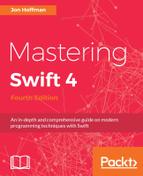The problem that the singleton pattern is designed to address is when we need one and only one instance of a type for the lifetime of the application. The singleton pattern is usually used when we need centralized management of an internal or external resource, and a single global point of access. Another popular use of the singleton pattern is when we want to consolidate a set of related activities needed throughout the application that do not maintain a state in one place.
In Chapter 5, Classes and Structures, we used the singleton pattern in the text validation example because we only needed one instance of the text validation types throughout the lifetime of the application. In this example, we used the singleton pattern for the text validation types because we wanted to create a single instance of the types that could then be used by all the components of the application without requiring us to create new instances of the types. These text validation types did not have a state that could be changed. They only had methods that performed the validation on the text and constants that defined how to validate the text. While some may disagree with me, I believe types like these are excellent candidates for the singleton pattern because there is no reason to create multiple instances of these types.
